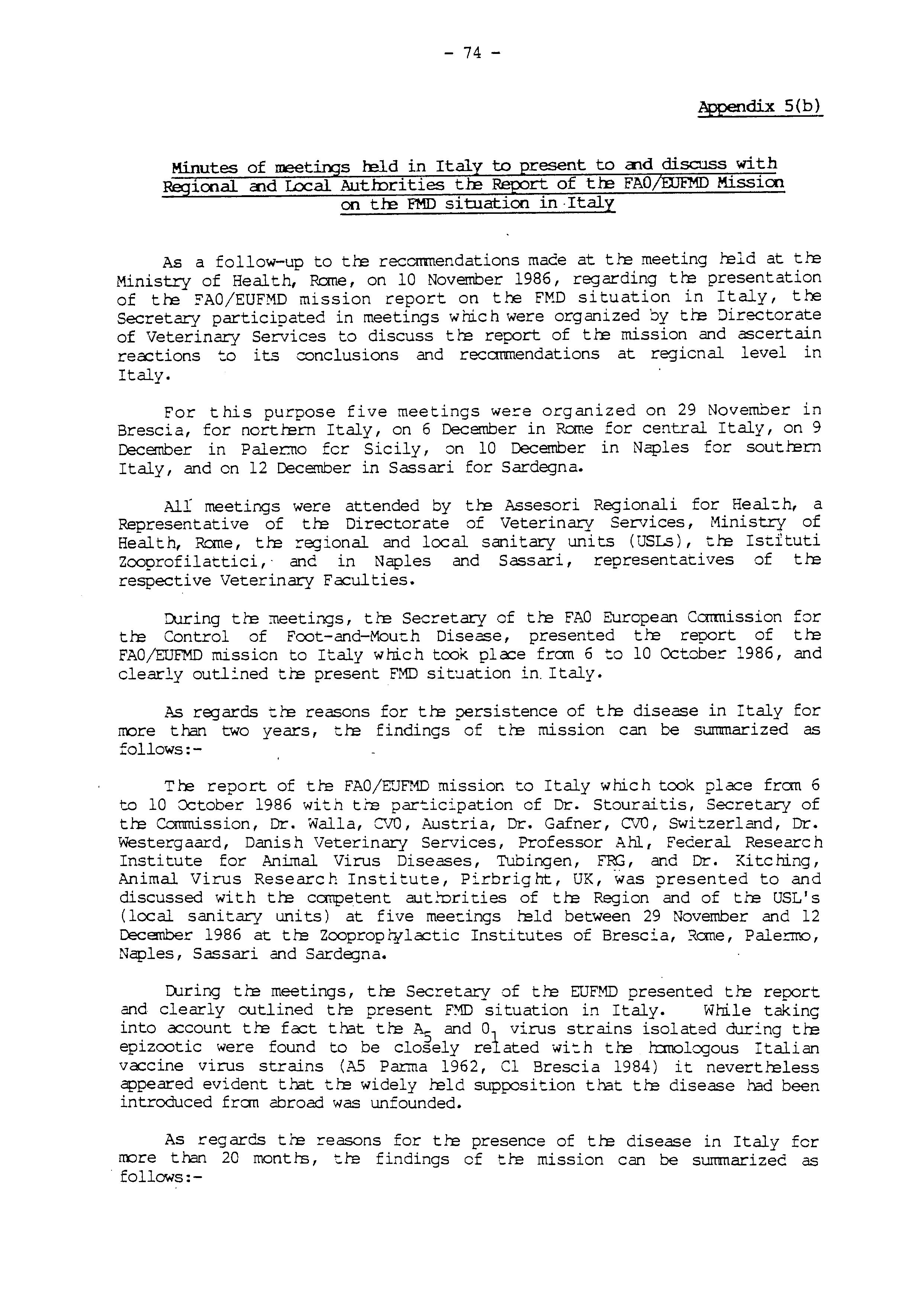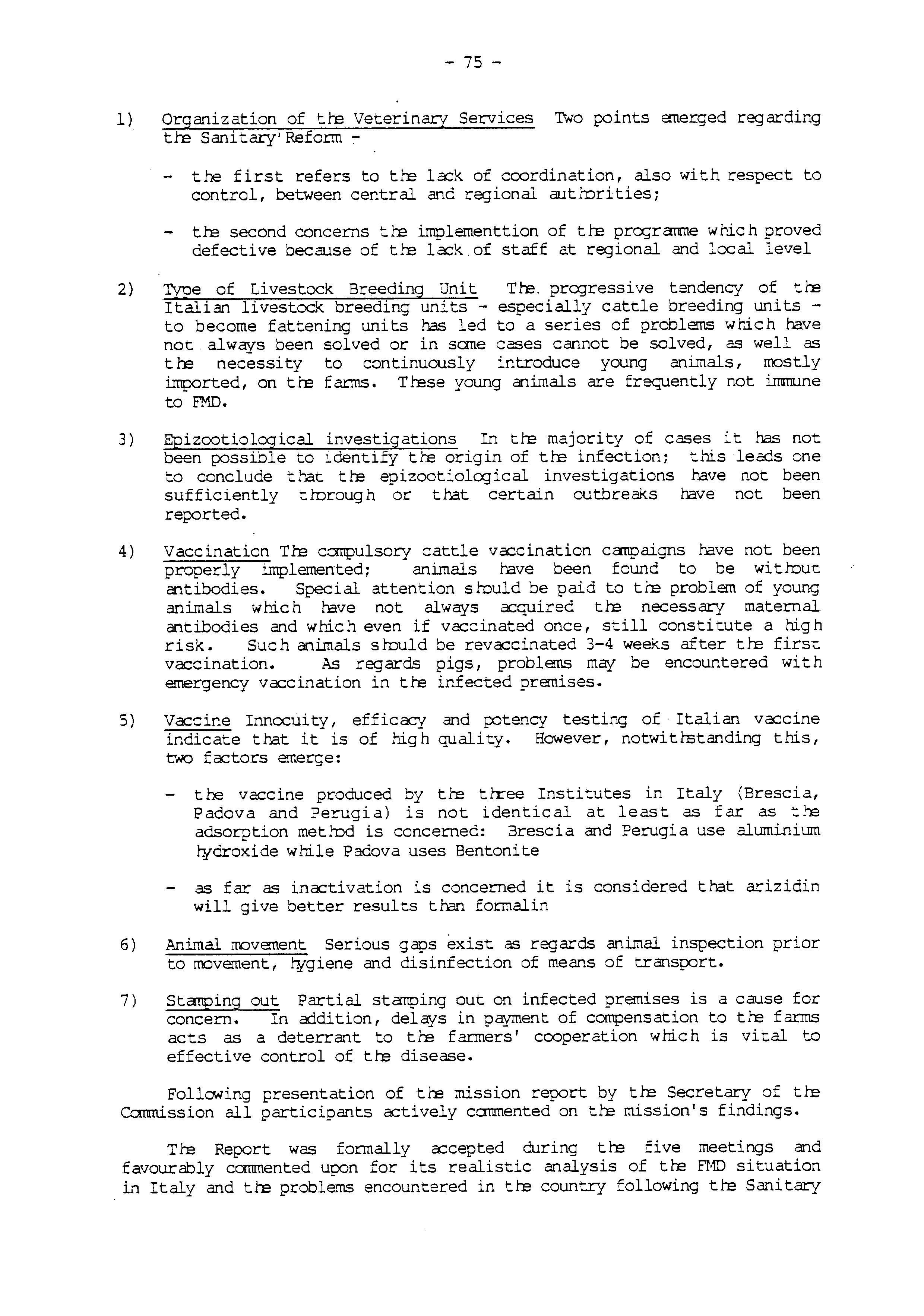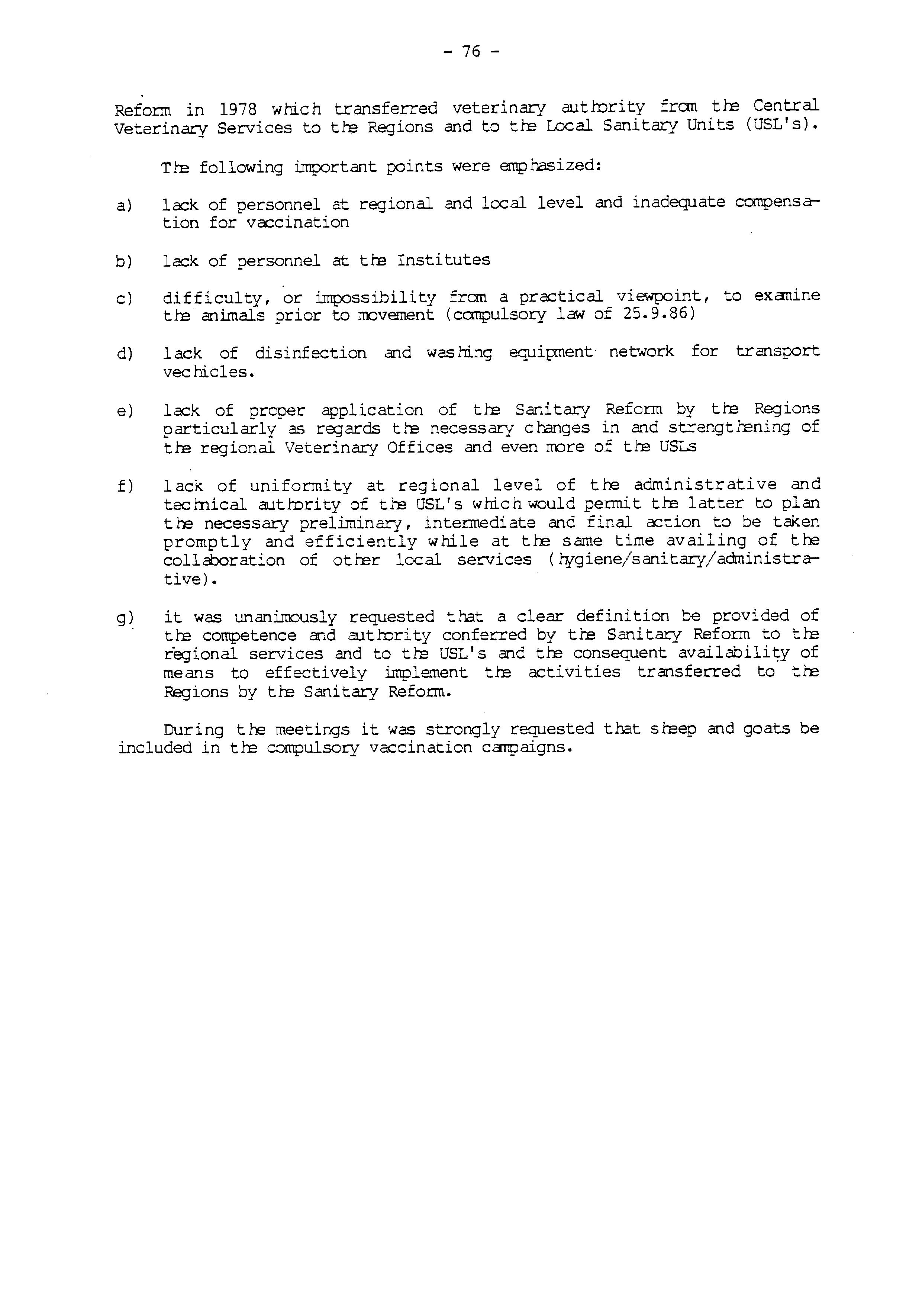
5 minute read
situation in Italy
Appendix 5 (b)
Minutes of meetir~:S reld in Italy to present to c11d diSOJSs with Regional (;().d Local Aut.fnrities t.te Report of t.te FAO/El]FMD Mission on t.te FMD situation in-Italy
Advertisement
As a follow-up to tl:e reccrrmendations mace at tt.:e meeting reld at tre Ministry of Heal th, Rane, on 10 November 1986, regarding t 1:e presentation of tt.:e 5'A0/EUFMD mission report on the FMD situation in Italy, too Secretary participated in meetings w hie h were organized by t re Director ate of Veterinary Services to discuss tre report of tre mission and ascertain reactions to its conclusions and recarmendations at regicnal level in Italy.
For this purpose five meetings were organized on 29 November in Brescia, for nortl:ern Italy, on 6 December in Rome for central Italy, on 9 Cecernber in Paler:no fer Sicily, on 10 December in Naples for soutrern Italy, and on 12 Cecernber in Sassari for Sardegna.
All meetings were attended by th= Assesori Regionali for Heal::h, a Representative of tre Directorate of Veterinary Services, Ministry of Health, Rane, tre :regional and local sanitary units (USLs), t.1:e Istftuti Zooprof ilattici, · and in Naples and Sassari, representatives of t.1:e respective Veterinary Faculties.
During t.1:e meetings, t.1:e Secretary of tre FA0 European Carrnission for tre Control of Foot-and-Mout.h Disease, presented t.1:e report of t.1:e FA0/EUfMD mission to Italy which took place fran 6 to 10 Cctober 1986, and clearly outlined th: present FMD sitJation in. Italy.
As regards th: reasons for t.1:e persistence of t.1:e disease in Italy for rrore than two years, t.1:e findings of t.1:e mission can be summarized as follows:-
The report of tr:e FA0/EUFMD mission to Italy which took place fran 6 to 10 :Jctober 1986 with th: participation of Dr. Stouraitis, Secretary of tr:e Ccrnmission, Dr, Walla, CV0, Austria, Dr, Gafner, CVO, Switzerland, Dr. Westergaard, Danish Veterinary Services, Professor Ahl, Feder al Research Institute for Animal Virus Diseases, Tubingen, FRG, and Dr, Kitching, Animal Virus Research Institute, Pirbright, UK, was presented to and discussed with tre canpetent aut:nrities of t.1:e Region and of t.1:e USL's (local sanitary units) at five rneet.ings r:eld between 29 November and 12 Cecernber 1986 at tr:e Zooproplylactic Institutes of Brescia, ~ane, Palermo, Naples, Sassari and Sardegna.
wring t.1:e meetings, t.1:e Secretary of tre EUFMD presented th: report and clearly cutlined tr:e present F½D situation in Italy. While taking into account tl:e fact that tr:e A,. and O virus strains isolated dur:ng t.1:e epizootic were found to be clogely re!ated with t.1:e h:molcgous Italian vaccine virus strains (AS Paz:ma 1962, Cl Brescia 1984) it nevertreless appeared evident that tl:e widely 1:eld supposition that tre disease had been introduced fran abroad was unfounded.
As regards tr:e reasons for tr:e presence of t.1:e disease in Italy fer rrore than 20 month,, tr:e findings of tr:e mission can be sumnarizec as follows:-
1) Organization of tre Veterinarf Services Two points ernecged regarding tre Sanitary' Reform :-
- the first refers to tre lack of coordination, also with respect to control, between central and regional autrorities;
- tre second concerns tre implernenttion of tre pra;;ranme w.rich proved defective because of tre lack. of staff at regional and local level
2) Type of Livestock Breeding Unit Tre. prcx;;ressive tendency of tre
Italian livestock breeding units - especially cattle breeding units to become fattening units has led to a series of problems w.hich have not always been solved or in sane cases cannot be solved, as well as tre necessity to continuously introduce young animals, mostly imported, on tre farms, Trese young animals are frequently not irmn.me to FMD,
3) Epizootiolo;iical investigations In tre majority of cases it has not been p::>ssible to identify tre origin of tre infection; this leads one to conclude t.bat tre epizoot:olcg-ical investigations have not been sufficiently trorough or that certain outbreaks have not been reported.
4) Vaccination Tre canpulsory cattle vaccination ca:npaigns have not been properly implemented; animals have been found to be witrout antibodies. Special attention s rould be paid to tre problem of young animals which have not always acc:;uired tre necessary maternal antibodies and which even if vaccinated once, still constitute a high risk. Such animals srould be revaccinated 3-4 weeks after tre first. vaccination. As regards pigs, problems may be encountered with emergency vaccination in tre infected premises.

5) Vaccine Innocuity, efficacy and i;:otency testing of· Italian vaccine indicate that it is of high quality. However, notwitratanding this, two factors emerge:
- the vaccine produced by tre trree Institutes in Italy (Brescia,
Padova and Perugia) is not identical at least as far as tl':e adsorption metrod is concerned: Brescia and Perugia use aluminium cydroxide while Pad.ova uses Bentonite
as far as inactivation is concerned it is considered that arizidin will give better results than formalin
6)
7)
Animal m:::ivement Serious gaps exist as regards animal inspection prior to move.rnent, cygiene and disinfection of means of transport.
Sta:nping out Partial stamping out on infected premises is a cause for concern. In addition, delays in payment of compensation to the farms acts as a deterrant to tre farmers' cooperation which is vital to effective control of tre disease.
Folla,.;ing presentation of tre mssion report by tre Secretary of tl-E canmission all participants actively canmented on tl-E mission's findings.
Tl-E Report was formally a::cepted during tre five meetings and favourably ccmnented upon for its realistic analysis of tre FMD situation in Italy and tre problems encountered in tre country following tre Sanitary
Reform in 1978 which transferred veterinary autrority :ran tre Central Veterinary Services to tre Regions and to t:re Local Sanitary Units (USL's).
Tre following important points were emphasized:
a) lack of personnel at regional and local level and inadequate ccrnpensation for vaccination
b) lack of personnel at tre Institutes
c) difficulty, or impossibility :ran a practical viewpoint, to exanine tre animals prior to :rovernent ( canpulsory law of 25. 9. 86)
d)
lack of disinfection and washing equipment network for transport vechicles.
e) lack of proper application of tre Sanitary Refor:m by tre Regions particularly as re:Jards tre necessary changes in and st:::'engtrening of tre regional Veterinary Offices and even m::ire of tte USLs
f) lack of uniformity at regional level of tre administrative and tecmical autrority of t.i-E USL' s which would permit tre latter to plan the necessary preliminary, intermediate and final act:.ion to be taken promptly and efficiently while at the same time availing of the collaboration of otrer local services ( cygiene/sanitary/administrative).
g)

it was unanirrously requested t11at a clear definition be provided of tre competence and aut.lurity conferred by tre Sanitary Reform to tre r·egional services and to tre USL' s and tre consequent availabili"l:,y of means to effectively implement tre activities transferred to tre Regions by th: Sanitar1 Reform.
During tre meetings it was strongly requested t11at sreep and goats be included in tre compulsory vaccination car.paigns.










